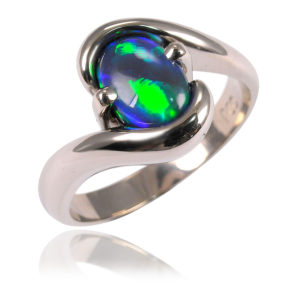The fascination with Opal Engagement Rings has been steadily on the rise in the past 5 or so years, particularly with the popularity of sharing platforms such as Pinterest becoming a virtual wish list of all things pretty, unique and tempting.
We’ve been happily assisting customers seeking THE ring in this time, and though we have done a few articles on what to look for and consider, it’s time for an update.
Firstly, Australian Opal has a hardness of 6.5/10 on the hardness scale, so this puts it on par with glass in terms of wear. It is a softer stone (not brittle, as Emerald is), and can be scratched if not careful with it. That said, a solid, protective setting will be adequate in keeping your opal in good shape.
So let’s look at the contributing factors to an effective engagement ring –
The domed surface of the opal (cabochon) does add to it’s play of colour and appeal, BUT, a high cabochon in an everyday engagement ring can make it vulnerable for knocking, so be aware of that. We generally recommend a medium or low cabochon. Boulder Opal (which has an undulating surface, and generally flatter than standard cabochon opals) is a great choice for this.
Sure, for some, bigger is better, but sometimes the conservative approach is more effective. We normally don’t recommend going any further than say, a 10mm x 8mm (which is still considerably big for a ring stone) Oval for an engagement ring. This one would come down to proportion – finger size vs opal size. Obviously if the person who is to wear the ring is only a Size J (US size 5), then a large stone is going to look on the extravagant side. While this could be the look you’re going for, it’s not really practical for an everyday setting.
Modern? Contemporary? Traditional? Think of the person’s style and taste. No point in designing some avant-garde ring, when the person is only interested in a simple setting with a couple of accent stones.
For opal, we recommend Yellow or White Gold (14k or 18k variations) the most. Silver is too soft, so if you’re wanting the white metal look stick to White Gold (silver can actually be harder to polish as well, which adds to the labour cost). Rose Gold, while currently on trend, is not completely compatible with opal tone wise… we find that it clashes. This one’s entirely up to the personal taste though. And Platinum is much too hard to do protective settings safely for opal.
This is a hard one to try and get over the line for us. A lot of clients love the traditional style of the claw (prong) setting, so we do tend to oblige with their wishes. We do need to point out though, that this style is no where near as protective as a bezel or even half-bezel setting. If you’re asking us for tips, this will be one of the first ‘rules’ we would point out to you. Better to have the stone protected, than to have it exposed.
Try and get this before the setting is made. Resizing isn’t TOO much of an issue, as long as it’s within 4 sizes up or down. Best to get the size right the first time though (ask us for some tips to do this)
Be reasonable with your budget. We just simply can’t create a custom setting in 18k Yellow Gold and Black Opal for AU$300 (we’ve seen this quite a few times). Look to spend around AU$1,000 for a simple setting (anywhere up to AU$3,000 + for something more extravagant), then add the cost of the opal. Trust us, it will be worth it.
As pretty as they are, inlay rings are not practical, and virtually useless as an engagement ring. Why? The opal is glued into the setting, and frequent immersion in water will cause the opal slivers to peal away. Simply put, don’t do it. Rethink the design.
Hopefully these tips will guide you to the perfect ring. For any further advice, email us at [email protected]


